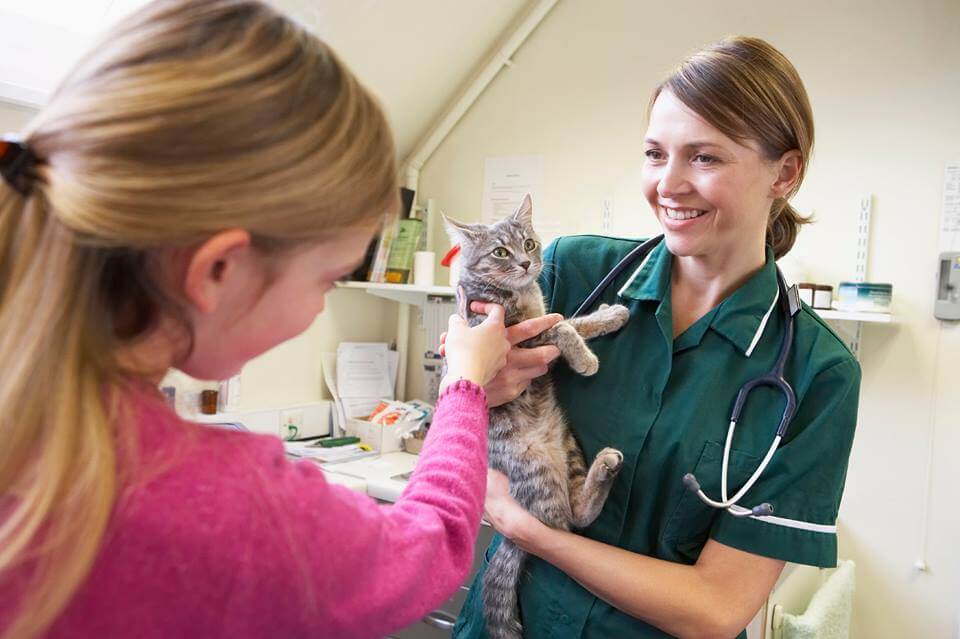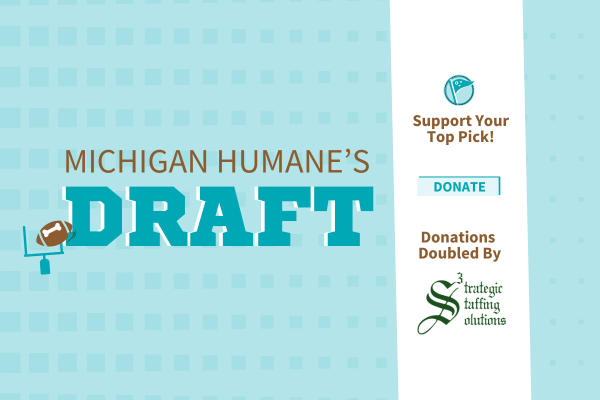Check out the Michigan Humane Society blog on Mondays to see common veterinary questions answered. If you have an immediate medical concern with your pet, please call your veterinarian! If you have a non-urgent question you would like answered on the blog, you can comment here or email us at mail(at)michiganhumane.org.
Fleas are a well-known problem of household pets, especially in the warmer months of the year. Common fleas infect both cats and dogs and can be transmitted between them. Fleas can live on your companion animal, in your house, the doghouse, your yard, the neighbor’s yard and even the neighborhood park and can cover ground equal to one mile in just one hour! Adult fleas live from six months to one year and can survive up to two months without food. Pets, mice or anyone entering your home can bring in fleas. Because of their mobility, there is no place in your house where a flea cannot go.
Fleas feed on animal blood and reproduce by laying hundreds of eggs which fall into pet bedding, furniture, carpeting and cracks in the floor. Eggs can hatch in as little as one week or as long as two years, depending on environmental conditions.
Adult fleas spend less than 5% of their time on your pet and it is estimated that for every flea found on your pet there are 75100 more loose in your house!
HEALTH CONCERNS
It is not “normal” for companion animals to have fleas. They are an annoyance to you, a health hazard to your pet and can transmit internal parasites such as tapeworms. Some pets are allergic to the bites of fleas and develop an allergic dermatitis: severe itching, hair loss, skin irritation and redness. In addition, some people are also allergic to flea bites.
Young kittens and puppies can die from anemia due to overwhelming flea infestations.
FLEA CONTROL
Flea control is not easy and is not a one-time endeavor. Persistence and patience are necessary. Treatment of your house and yard is as important as treatment of your pets. The entire house, the yard and all pets must be treated simultaneously in order to control a flea problem. Diligent flea control is the only sure way to keep a flea problem minimized. Treating for fleas only once or for a brief period of time WILL NOT resolve a flea problem. You will only kill newly hatched and adult fleas but the eggs will remain viable and hatch a new crop of hungry fleas.
TREAT THE PET
Do not use any flea products on newborn or young pets unless the product is specifically made for them. Bathing your pet in a flea shampoo will only kill the fleas that are on the animal at the time of the bath. Shampoos will not prevent new fleas from climbing aboard your pet once he dries. You will need to use a flea-repellent to prevent him from becoming re-infested and all pets in the household must be treated simultaneously.
If you use a flea-repellent powder* or spray* be sure to follow all of the directions on the product or use as advised by a veterinarian.
Always use high quality flea products or treatments. There are many newer flea repellent products on the market. Frontline® Top Spot is just one. It is a pre-mixed, pre-measured liquid that, when placed on your pet’s skin, protects him from fleas and ticks. Frontline® comes in various sizes, based on the weight of the dog, and is also available for cats. It is highly effective, only needs to be applied once a month and has been proven to be safer for your pet than many of the older sprays and powders.
Flea collars alone are not effective. Some collars may help to keep fleas off the head
and neck areas, but the fleas then usually stay in the tail and underbelly regions. Some pets may develop a contact dermatitis in the neck area and some (cats, kittens and young pups in particular) can become ill from sensitivity to the insecticide in the collars. In addition, flea collars can be dangerous if they get stuck in a pet’s mouth, so, if you use them, do so with caution.
*Whichever products you use, follow directions and repeat treatment in accordance with label instructions.
TREAT THE HOUSE
Vacuum! The best way to treat the house is by vacuuming thoroughly and often. Use particular care in areas that your pet frequents. Vacuuming up a few teaspoons of flea powder before going over your carpets will aid in killing fleas as they come into the vacuum bag. Remove and discard the bag after each vacuuming.
House treatment sprays containing either chlorpyrifos* or methoprene* are highly effective, easily used and have good residual action (to kill hatching fleas). They can be used safely on carpets and furniture, but should NEVER be used directly on a pet unless specifically labeled for this use.
For severe flea infestations, it may be necessary to also use flea “bombs” or foggers*. These are canisters of insecticide vapor which are activated in closed rooms of your house and allowed to fumigate for several hours while you and all your pets are away. They are most effective when used twicethree to six weeks apart.Some households are so heavily infested that none of the recommended treatments are adequate. In these cases a professional exterminator becomes necessary to get the flea problem under control. Choose an exterminator who treats specifically for fleas and whose work is guaranteed. The cost is usually reasonable and the results excellent.
TREAT THE YARD
In all but the cold winter months, your yard can be a source of flea infestation and re-
infestation. You should treat your yard three times at 14-day intervals during the same time period as treating your house and pets. Do not treat on a day when rain is forecast. Spray a large yard with chlorpyrifos*. Dust a small yard with malathion* or diazinon*. These products are readily available in the garden department of many stores. Follow label directions explicitly.
A complete flea control program takes time, and once you have succeeded in ridding your house, yard and pets of fleas, it’s best to continue with your chosen method of flea control to keep them away. The results will be happier, healthier pets with fewer trips to the veterinarian for skin problems.
*As with all chemical products, read the labels of all flea products carefully and follow all instructions and recommendations. Many products can be dangerous to your pet if not used properly.


